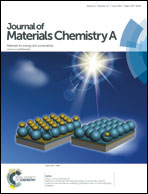A work-function tunable polyelectrolyte complex (PEI:PSS) as a cathode interfacial layer for inverted organic solar cells†
Abstract
High-efficiency inverted polymer solar cells (PSCs) with a polyelectrolyte complex, polyethylenimine:poly(styrenesulfonate) (PEI:PSS), as the cathode interfacial layer for efficient electron extraction are demonstrated. By introducing the negatively charged PSS− as the counter ions into PEI, the imine protonation could be tuned, leading to tunable work-function of the PEI:PSS coated ITO. The incorporation of PSS in PEI enhances the photocurrent and power conversion efficiency (PCE) of the devices, due to an improved electron extraction at the PEI:PSS–active-layer interfaces. Furthermore, a TiOx–PEI:PSS combined interfacial layer further enhances the cell performance and eliminates the need for light-soaking treatment for TiOx, owing to the improved hole-blocking and surface-state passivation in the interfacial layer. The achieved high cell performance, better stability, low-cost materials, and low-temperature solution processes of the TiOx–PEI:PSS interfacial layers demonstrate a promising cathode configuration for realizing efficient and long lifetime PSCs.


 Please wait while we load your content...
Please wait while we load your content...